Myanmar
Things to DO
Nyaungshwe
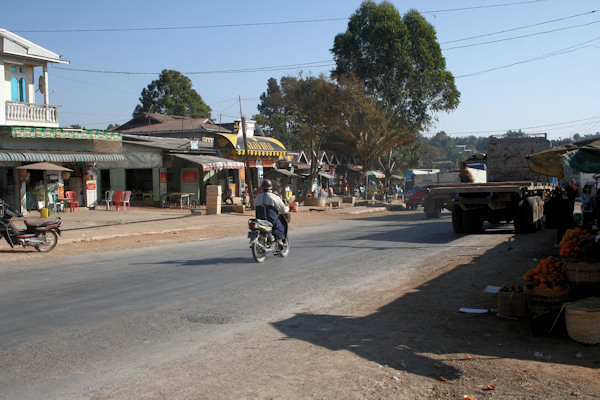 |
|||||
Laid-back Nyaungshwe's choice accommodation and diverse activities is situated about 3.5km from the northern end of the
Inle Lake.
Besides Kalaw, this town is one of the few places in the country to exude a backpacker vibe, evidenced by the number of inexpensive
but comfortable guesthouses and restaurants specialising in spaghetti and pancakes.
The main municipal zei (market), near the northern entrance, is busiest in the morning, when vendors congregate to sell their
wares. In addition to mountains od fresh products, there are a few stalls selling pottery and textiles.
The oldest temple in town, Yadana Man Aung Paya, is worth visiting for its unique step-spired stupa. Look for the "you will
be old" and "you will be sick" figures in glass cases in one of the shrine buildings.
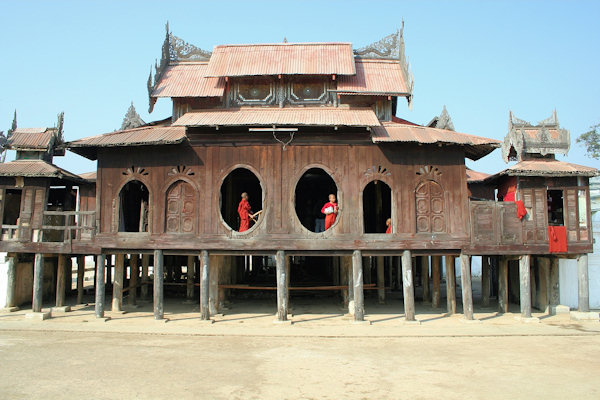 |
|||||
Shwe Yaunghwe Kyaung, build 18th- or 19th-century, is a wooden monastery with tiered roofs standing on chunky stilts.
Its large oval-shaped windows are said to be highly idiosyncratic architecturally; in almost every window sits a young monk in
his magenta robes, relaxing in between sessions of study and meditation and gazing impassively out at the hustle and bustle of life
on the road outside the tranquil, venerated grounds of their sanctuary.
In the airy ordination hall, elder monks are poring over sacred Pali texts, perhaps finding verses of particular relevance in
which to edify novices in the upcoming afternoon study session.
A short walk south of Nyaungshwe along the eastern side of the main channel leads to the small but atmospheric ruins of
Kyaukhpyugyi Paya, next to the Intha village of Nanthe.
Surrounded by brick-and-stucco "Devas" (celestial beings), "Chinthe" (half-lion, half-dragon guardian deities) and stupas
is a huge sitting Buddha, said to be 700 years old.
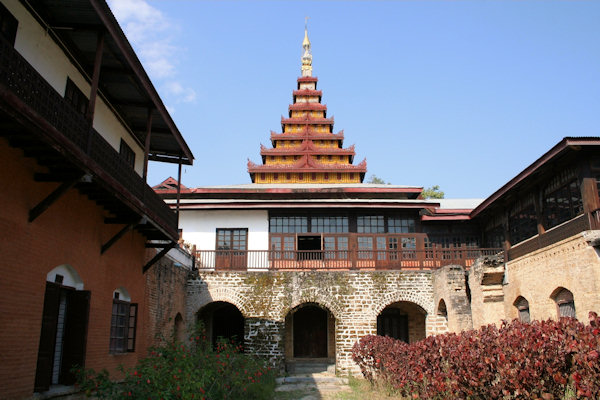 |
|||||
Museum of Shan Chiefs
Housed in a large teak-and-brick mansion in the northeastern part of town, this Museum was
the "Haw" (palace) of the 33rd and last Shan
Sao Shwe Thaike.
Thaike, who became the firts president of Myanmar in 1948 was imprisoned when Ne Win came to power in 1958, and died in jail.
The museum is the best surviving example of a Shan-style palace, many of the rooms contain displays of Shan furniture and royal
costumes.
Monks get bored just like the rest of us, so the monks at Nga Hpe Kyaung have trained their cats to leap through small
hoops.
The monks have expressed some frustration with visitors who make cat-jumping demands while they (the monks) are occupied with
things such as eating and meditating. Otherwise they seem willing to oblige visitors.
But an even better reason to visit is the modest collection of Buddha images in Shan, Tibetan, Bagan and Inwa (Ava) styles.
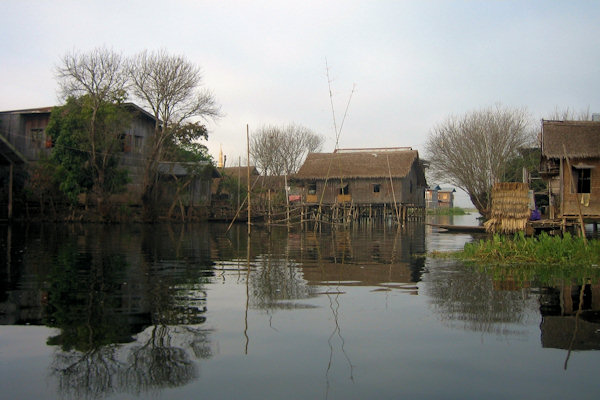 |
|||||
Inle Lake
The lakeshore and lake islands are home to 17 villages on stilts, which are mostly inhabited by the Intha people.
The lake doesn't really have a shoreline - you can't walk directly around it. The water gets shallow and the tangled hyacinths
and marsh paddles get denser until the obstacle course becomes unnavigable and you reach solid land.
The industrious villagers inhabiting the lake region support themselves by growing a wide variety of flowers, vegetables and
fruit year round.
Using cone-shaped nets streched tauntly over wood and bamboo frames, Intha fisherman harvest "nga-hpein" (a type of carp)
Women in the villages weave Shan-style shoulder bags and sil "Zinme" (Chiang Maistyle) "longyi" on wooden hand looms.
Even with the popularity of the western cigarettes, the cool and mild cheroot is still the preferred smoke, especially in
the countryside. Cheroots factory workers are mostly women; it gives them a chance to earn, without disrupting housework.
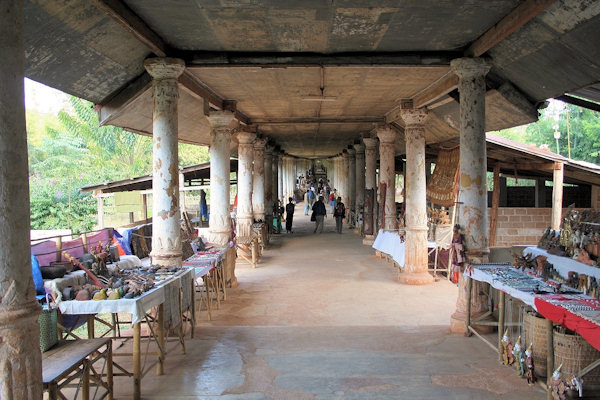 |
|||||
Indein
A large covered passagewaylined with hundreds of wooden columns is leading up the hill to an impressive collection of weather
beaten stupas collectively known as the Shwe Inn Thein Pagoda.
According to evidence provided by the Inn Tein Stone Inscription, the first religious monument in this locality was donated in
the 20th year of the Buddhist Calendar (around 250 BC.) by the great missionary emperor Thiridhamman Thawka
(King Asoka).
Later, it is said that King Anawrahta of Bagan and one of his descendants Narapati Sithu made donations towards
renovations and the building of additional stupas.
The stone figures and statues and the floral designs that adorn the stupas show the high standard of the artists and artisans
of those ancient days. The workmanship of these works of arts is contemporary to that of the Bagan eras.
Mandalay
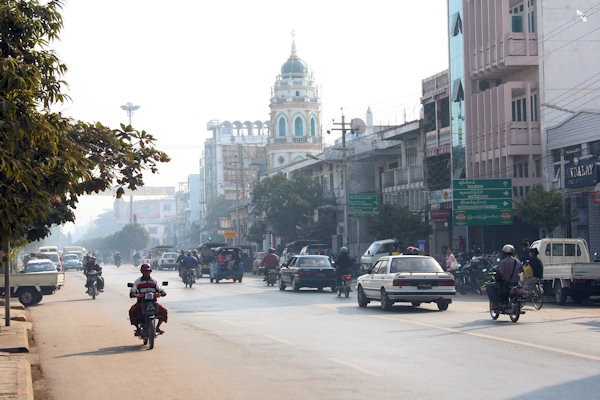 |
|||||
King Mindon Min, penultimate ruler in the Konbaung dynasty, founded the city in 1857 and began constructtion
of his new capital, which moved from Amarupura in 1861.
In true Myanmar tradition, the new palace was mainly constructed from the dismantled wooden buildings of the previous palace at
Amarapura.
Mandalay's period of glory was short - Mindon was succeeded by the disastrouss Thibaw Min and in 1885 Mandalay was taken
by the British. Thibaw and his notorious queen were exiled and "the centre of the universe" or "the golden city"
(as it was known) became just another outpost of the British Empire.
Fifteen years after independence in 1947, Mandalay slumbered, like the rest of the country, through the socialist mismanagement
of Ne Win and company.
However, with the reopening of the Burma Road through Lashio to China the city has been undergoingan economic boom since the 1990's.
The money fuelling this boom is generated by three trades - rubies, jade and heroin - and controlled by Kachin, Wa, Shan, Kokang
and Chinese syndicates.
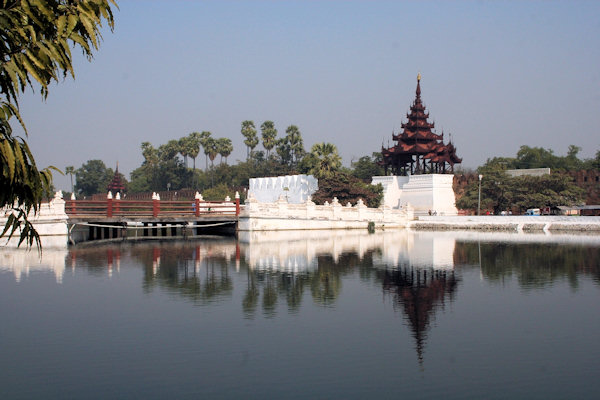 |
|||||
Mandalay Palace & Fort
The overwelming centrepiece of Mandalay, the Palace Compound, sprawling south of Mandalay Hill, is surrounded by a fort made up of
immense 3,2km-long, 8m-high walls and guarded by a 70m-wide moat.
The original palace was more than just royal living quaters; it was a walled city within Mandalay. It served as the home to two
Burmese kings, King Mindon Min (who built the palace in 1857) and King Thibaw (who lived here until British forces
seized the city in 1885)
Afterwards the British used the palace as the colony's government house and British Club.
The Japanese held Mandalay for much of WWII. In march 1945, amid fierce fighting from advancing British and Indian troops, the royal
palace caught fire and was destroyed.
The palace was rebuild in the late '90s.
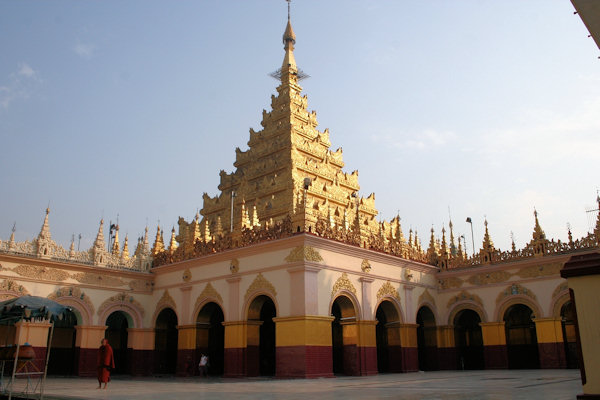 |
|||||
In Southwest Mandalay stands one of Mayanmar's more famous Buddhist sites; Mahamuni Paya, which was originally
built by King Bodawpaya in 1784.
The paya's fame comes from its shrine centrepiece, the highly venerated Mahamuni Buddha image; which was seized from Mrauk U
in Rakhaing (Arakan) State in 1784. It was believed to be of great age even at that time and it may even been cast during the
1st century AD (although many in Rakhaing believe it date from a legendary visit by the Buddha in 554 BC)
The 4m-high seated image is cast in bronze, but over the years thousands of devout Buddhist have completely covered the figure in a
15cm-thick layer of gold leave.
Only Man are permitted to walk up to the Mahamunni image and apply gold leave.
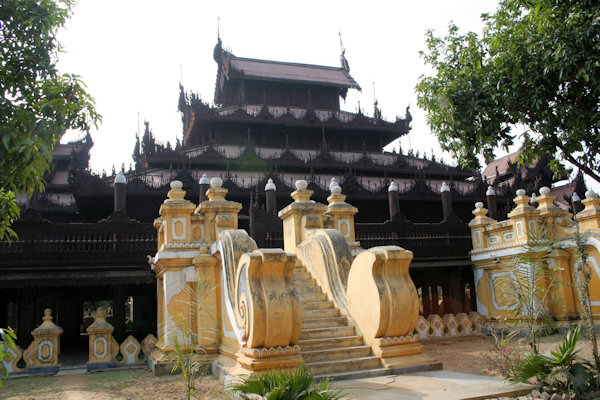 |
|||||
The large and elegent Shwe In Bin Kyaung dates from 1895, when a pair of wealthy Chinese jade marchants commissioned
it.
Called simply "The Teak Monastry" by many locals, the central building stands elevated on tall poles, and its balustrades
and roof cornices, are covered in detailed engravings.
The eastern section of the monastery, which is open to visitors, includes a remarkable centrally-placed Buddhist altar and ample
indoor space for monks to greet a variety of visitors or hold larger assemblies.
The west apartment, not open to visitors, was used the monks' dormitory.
It's incredibly peaceful and seldom crowded.